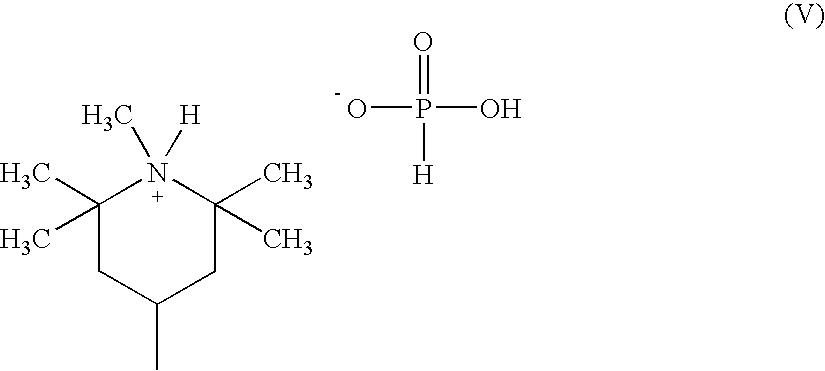Aluminum/alkaline or alkali/titanium containing polyesters having improved reheat, color and clarity
a technology of alkali or alkali and polyester, which is applied in the field of polyester polymers, can solve the problems of resin reheat rate, inability to absorb infrared dyes, and negative effects on the visual appearance of pet containers, etc., and achieve the effect of improving the reheat rate of polyester composition
- Summary
- Abstract
- Description
- Claims
- Application Information
AI Technical Summary
Benefits of technology
Problems solved by technology
Method used
Image
Examples
example 1
Li / Al Catalyst System
[0326] A catalyst solution containing 0.27 wt % Li was prepared by combining 3.97 g lithium acetate dihydrate (obtained from Aldrich Chemical Co.) and 96.03 g distilled water. Another catalyst solution containing 0.32 wt % Al was prepared by combining 1.71 g aluminum acetate containing boric acid stabilizer (CH3CO2Al(OH)2.1 / 3H3BO3) (obtained from Aldrich Chemical Co.) and 98.29 g distilled water.
[0327] PET oligomer was prepared by charging purified terephthalic acid (PTA), purified isophthalic acid (PIA) and ethylene glycol (EG) to a 2-L autoclave. The charged amounts were as follows: 651.0 g PTA, 13.0 g PIA and 396.0 g EG. The raw materials were reacted at 245° C. and 40 psig for 200 minutes. At the end of the reaction, the oligomer was discharged from the reactor and allowed to solidify at room temperature and was then pulverized to a coarse powder.
[0328] In a second step, a polymer was prepared from the oligomer in the following manner. Oligomer (111 g), L...
example 2
Li / Al Catalyst System and Titanium Nitride (TiN)
[0343] The procedure of Example 1 was followed, except that titanium nitride (TiN) was added to the polymer. The TiN nanopowder was obtained from Nanostructured & Amorphous Materials (catalog number 5350KE). The nominal particle size was 25 nm, and the measured d50 particle size was 15 nm as determined by transmission electron microscopy (TEM). A dispersion containing 0.25 wt % TiN was prepared by combining 0.315 g TiN along with 124.685 g EG. A portion of the TiN dispersion (0.27 g) was added to the oligomer along with the Li and Al catalyst solutions. The targeted level of TiN based on the final polymer weight was 6.8 ppm TiN. The Ti concentration in the polymer was determined by x-ray fluorescence (XRF). The RIT was determined as described above.
Conclusions Based on the Examples
[0344] The results for the examples are given in the Table. Example 1 shows the results for a polyester made with a Li / Al catalyst system and post-polyco...
PUM
| Property | Measurement | Unit |
|---|---|---|
| Temperature | aaaaa | aaaaa |
| Temperature | aaaaa | aaaaa |
| Temperature | aaaaa | aaaaa |
Abstract
Description
Claims
Application Information
 Login to View More
Login to View More - R&D
- Intellectual Property
- Life Sciences
- Materials
- Tech Scout
- Unparalleled Data Quality
- Higher Quality Content
- 60% Fewer Hallucinations
Browse by: Latest US Patents, China's latest patents, Technical Efficacy Thesaurus, Application Domain, Technology Topic, Popular Technical Reports.
© 2025 PatSnap. All rights reserved.Legal|Privacy policy|Modern Slavery Act Transparency Statement|Sitemap|About US| Contact US: help@patsnap.com



